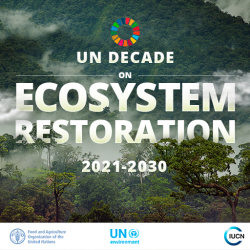Session D
Ecosystem Restoration
Session Description
Natural ecosystems provide services in the form of resources such as food, fuel, and timber; the purification of air and water; the detoxification and decomposition of wastes; the regulation of climate; the regeneration of soil fertility; and the pollination of crops. These ecosystem processes have been estimated to be worth trillions of dollars annually. There is consensus in the scientific community that the current environmental degradation and destruction of many of the Earth’s biota is taking place on a “catastrophically short timescale”. Habitat loss is the leading cause of both species extinctions and ecosystem service decline. Two methods, the conservation of currently viable habitat, and the restoration of degraded habitat, have been identified to slow the rate of species extinction and ecosystem service decline. The commercial applications of ecological restoration (ER) have increased exponentially in recent years. The United Nations General Assembly (2019) declared 2021 – 2030 the UN Decade on Ecosystem Restoration.
ER is the academic study of the process, whereas ecological restoration is the actual project or process by restoration practitioners. The International Society for Ecological Restoration defines “ecological restoration” as an “intentional activity that initiates or accelerates the recovery of an ecosystem with respect to its health, integrity and sustainability”. ER includes a wide scope of projects including erosion control, reforestation, removal of non-native species and weeds, revegetation of disturbed areas, daylighting streams, reintroduction of native species (preferably native species that have local adaptation), and habitat and range improvement for targeted species. ER draws on a wide range of ecological concepts, such as: Disturbance, Succession, Fragmentation, Ecosystem functioning, Community assembly, and Population genetics. ER has several applications, among several others in: controlling species invasions, waste water purification, filtration and purification of air, food safety, sourcing material for restoration. There are many reasons to restore ecosystems, i.e. for applications of ER. These include: Restoring natural capital such as drinkable water or wildlife populations, helping human communities and the ecosystems upon which they depend to adapt to the impacts of climate change (through ecosystem-based adaptation), mitigating climate change (e.g. through carbon sequestration). Assisting threatened or endangered species, aesthetic reasons. Furthermore, there are ethic reasons, such as: human intervention has unnaturally destroyed many habitats, and there exists an innate obligation to restore these destroyed habitats to regulate the use/harvest, particularly for subsistence, cultural relevance of native ecosystems to Native people, environmental health of nearby populations. We will focus particularly on the advances and challenges in ER that holds for its conceptualization and aims, methodological approaches, practical applications in the One Health concept as well as for industries and society, and its sustainable implementation in a joint effort of academia, jurisdiction, and practitioners like architects and landscape engineers.
References
- Jørgensen, D. (2015). Ecological restoration as objective, target, and tool in international biodiversity policy. Ecology and Society 20(4):43.
- Wiegleb, G, Dahms, H-U, Byeon, W.I. and Choi, G. (2017). To what extent can constructed wetlands enhance biodiversity? International Journal of Environmental Science and Development 8 (8): 561-569.
- Wiegleb G, Bröring U, Choi G, Dahms H-U, Kanongdate K, Byeon C-W, Ler LG. (2013). Ecological restoration as precaution and not as restitutional compensation. Biodiversity and Conservation 22 (9): 1931-1948.
- https://www.unenvironment.org/news-and-stories/press-release/new-un-decade-ecosystem-restoration-offers-unparalleled-opportunity.
The session will focus on inter- and transdisciplinary research on ecological restoration. Our objective is to provide a broad set of research contributions covering four major issues of Ecological Restoration [ER].
- Theoretical approaches to describe, measure and analyze ER.
- Methodological-operational advances: from landscape engineering to resource remediation (e.g. bioremediation of soil and water)
- Transdisciplinary approaches from ER research towards realization of landscape and urban planning.
- Sustainable management of natural and urban ecosystems.
The ultimate aims are: providing safe basic natural resources (water, air, land), conservation of biodiversity, restauration of natural and cultural ecological integrity.
Linkage to Sustainable Development
Co-Hosts
Hosts
Co-organizer
LEE, PEI-HSUAN Assistant Research Fellow
Laboratory research technologies:
food microbiology,
fermented food science,
microbiological inspection,
functional food development,
applied microbiology,
food technology and traditional food development





